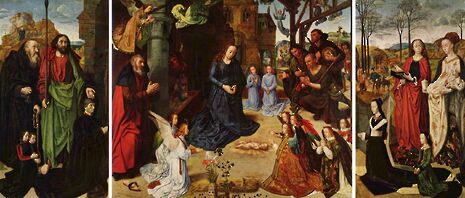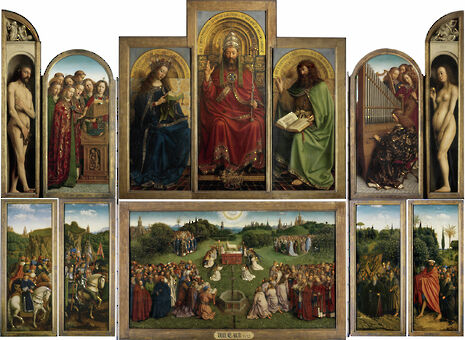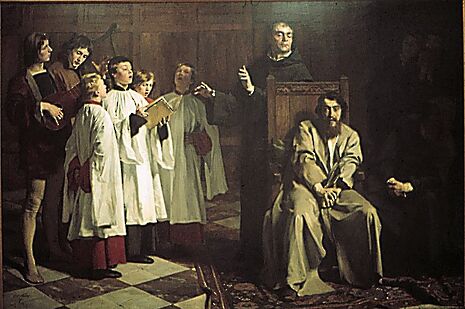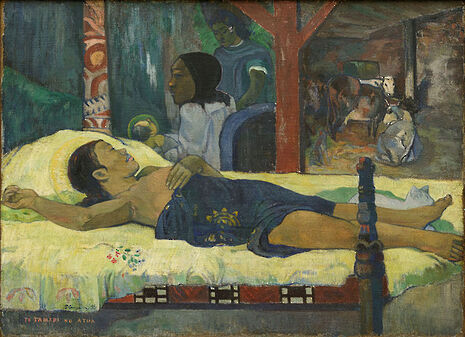The Ghost of Christmas Past: changing views of the nativity
Joseph Krol examines the link between Hugo van der Goes’ Portinari Altarpiece and van Gogh’s art, looking at the way the nativity has been depicted in secular ways by artists over the ages

The Florentines didn’t know what had hit them. It had taken a lot of work to bring the painting to Tuscany – after a long and hazardous sea voyage from Flanders to Pisa, it had been hauled hundreds of miles up the Arno, finally being carried by sixteen strongmen up to the Santa Maria Nuova.
The work was the Portinari Altarpiece by Hugo van der Goes, and it was to become one of the most influential works of the Renaissance. It is, quite simply, the nativity to end all nativities. Yes, the usual elements of the scene are there, but it is somehow different nevertheless. Solemn angels intermix with gurning shepherds; the trees are dead behind the black-clad worshippers. The painting is palpably real – indeed, it feels almost mournful in birth. One can nearly see the serene confidence of the Renaissance starting to crack, as if man was no longer quite sure of his place in the world.
“Vincent Van Gogh saw a kindred spirit in Van der Goes”
It remained in Florence down the centuries, but with time, its reputation began to wane. Knowledge of the painter himself was lost; he came to languish in almost complete obscurity. As attributions were forgotten, eventually only the Portinari Altarpiece clung desperately onto van der Goes’ name. This began to change in the mid-1800s, when a Belgian historian found a long-neglected manuscript by Gerard de Ofhuys, which told a rather macabre story.
While his masterpiece was reaching remarkable levels of fame in Florence, there was no Christmas spirit for van der Goes. While working on it, he had become monomaniacally obsessed with the idea of outdoing van Eyck’s great altarpiece at Ghent. In terms of influence, he was perhaps not far off. But the focus and hard work took its toll. Shortly after finishing the triptych, he suddenly shut down his workshop, became a monk, and slowly lost his grip on reality. Eventually, he became convinced of his own damnation on account of works like the Portinari Altarpiece. After an unsuccessful suicide attempt, he died not long after from depression, a year before his masterpiece reached Italy.

This is a harrowing tale of how something as outwardly benign as the nativity scene drove one of the most talented men of his generation to madness and self-hatred. It did not take long for the story to be transferred to canvas. The Belgian painter Emile Wauters later depicted a straggly, confused-looking van der Goes listening to a small choir, in what seems to be a curious sort of music therapy, in his Madness of Hugo van der Goes. While hardly in the highest class of paintings, this work was influential in its own way, via the intermediary of a more famous artist.
Vincent van Gogh saw a kindred spirit in van der Goes. They came from the same area, had similar names, were both pioneering artists, and were both wracked with mental illness. When he needs this imagery, it is this depiction of van der Goes he turns to, comparing himself to the “mad, wide-eyed painter” in his letters. Van Gogh was himself religious, in a characteristically odd way; he spent a few years living in a wooden hut while a missionary in the Belgian coalfields, before deciding he didn’t much like it and trying out art instead.

Van Gogh rarely painted religious scenes, but he was to have tremendous influence nonetheless. Some years later, he spent time working with Paul Gauguin – a former stockbroker who by then was a leading post-Impressionist. Van Gogh profoundly influenced Gauguin’s artistic beliefs, though they did not always see eye-to-eye. After van Gogh cut off his ear in a frenzied confusion, Gauguin wisely decided it was time to leave. In an effort to leave behind Western art, he eventually moved to Tahiti in the Pacific; the story finally comes full circle, for he decided to paint a strikingly unusual version of the nativity in 1896. Depicting his pregnant teenage Tahitian wife in the place of Mary, it is not obviously a religious work. There are subtle halos, but ultimately this is a scene of artistic realism, if displaced from its usual setting. Gauguin’s work is somehow universal, and yet somehow this act of rendering as usual something unusual expresses a quiet concern over religion’s place in society. His child, alas, was to die not long after birth.
Van der Goes and Gauguin were both drawing from the same religious story; one was van Gogh’s inspiration, the other the inspired. But the subtle questions seemingly posed by the altarpiece – is it right for the sacred to mix with the profane? Is there not death in every birth? – are answered, four short centuries later, by Gauguin. He seems to suggest that the religious is now inextricably linked to the commonplace. Looking at Christmas celebrations a century on, who could really disagree?

The underlying theme here is that views and experiences of Christmas can vary wildly; indeed, it is an especially difficult time of the year for mentally ill people. Even as society changes in this regard, we must respect that variation lies within it. Some may see the holiday season as an excuse for carefree festivities; others may prefer to spend it alone. In life as much as in art, there is room for different interpretations and different preferences, and this is something we must all remember to respect
 News / Caius mourns its tree-mendous loss23 December 2025
News / Caius mourns its tree-mendous loss23 December 2025 News / Clare Hall spent over £500k opposing busway 24 December 2025
News / Clare Hall spent over £500k opposing busway 24 December 2025 Comment / Yes, I’m brown – but I have more important things to say22 December 2025
Comment / Yes, I’m brown – but I have more important things to say22 December 2025 Interviews / Politics, your own way: Tilly Middlehurst on speaking out21 December 2025
Interviews / Politics, your own way: Tilly Middlehurst on speaking out21 December 2025 Comment / The ‘class’ of Cambridge24 December 2025
Comment / The ‘class’ of Cambridge24 December 2025







